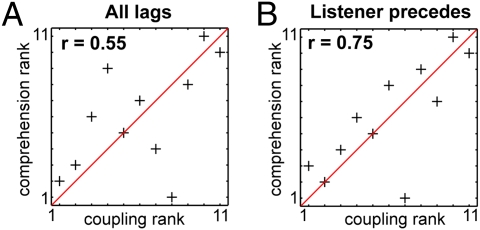Fig. 4.
The greater the extent of neural coupling between a speaker and listener the better the understanding. (A) To assess the comprehension level of each individual listener, an independent group of raters (n = 6) scored the listeners’ detailed summaries of the story they heard in the scanner. We ranked the listeners’ behavioral scores and the extent of significant speaker–listener coupling and found a strong positive correlation (r = 0.54, P < 0.07) between the amount of information transferred to each listener and the extent of neural coupling between the speaker and each listener (Fig. 4A). These findings suggest that the stronger the neural coupling between interlocutors, the better the understanding. (B) The extent of brain areas where the listeners’ activity preceded the speaker's activity (red areas in Fig. 3B) provided the strongest correlation with behavior (r = 0.75, P < 0.01). These findings provide evidence that prediction is an important aspect of successful communication.

